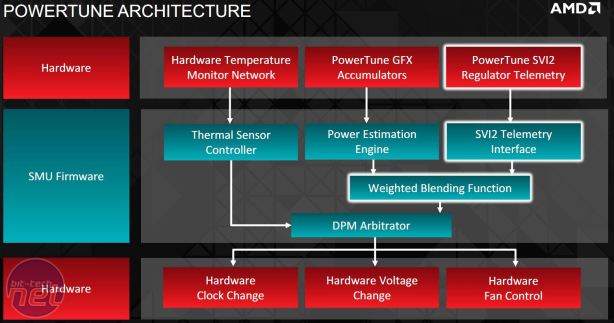Tuning up PowerTune
PowerTune, AMD's way of ensuring its cards stay within their power limits at all times, returns in the R9 290X with some upgrades at both the hardware and end-user levels. The card's overall performance at any time is now the result of a dynamic and more explicit relationship between the power limit, clock speeds, fan control and operating temperature, all of which can be configured by the user. At the heart of it is AMD's 2nd gen Serial VID chip (SVI2), a voltage regulation controller interface that's also found integrated into its socket FM2 APUs.In terms of power management, SVI2 features 255 6.25mV voltage steps between 0.00V and 1.55V that can be switched between approximately every 10 micro seconds, and it can control multiple voltage domains too. A dedicated telemetry line can carry up to 20Mbps of information relating to voltage and current. Along with data from the thermal sensors and PowerTune Estimation Engine, which estimates power requirements based on load, this telemetry data is used to harness a more precise and refined control of the hardware's voltages and clock speeds. The Dynamic Power Management (DPM) arbitrator always aims to go up one step on the voltage/clock scale if it will result in more performance, provided that doing so will still keep the card within its power, thermal and fan speed constraints.
The main result of all this for end users is a slightly modified approach to adjusting performance and overclocking, which we cover in more detail in the overclocking section. Generally though, since the core engine clock is fully dynamic, adjusting it is really changing its maximum speed (unlike Nvidia's latest cards where you're altering the middle of a boost curve). In practice, it will constantly fluctuate when under load as it takes into consideration, in real time, data about load and temperature to determine the optimal frequency and voltage. Dynamic boosting is nothing new, but the PowerTune optimisations are designed to make it more efficient.
Fan and noise control
The fan control, which is directly linked to PowerTune given its effect on temperature, has also seen some slight changes. With a user specified target temperature, it's able to work predictively to optimise noise output. This allows it to accelerate and decelerate slower than it might otherwise do with a basic fan curve. As our ears are more sensitive to sudden changes in air pressure than gradual changes, this supposedly results in a more pleasant experience.
Also under the realm of power management is ZeroCore, which is again featured on the R9 290X. This allows the GPU to become completely powered down (other than remaining visible to the OS and BIOS) when the system enters its long idle state and the screen turns off after a period of inactivity. In CrossFire set-ups it also disables in the same manner any secondary and tertiary GPUs, including their fans, in single GPU workloads.

MSI MPG Velox 100R Chassis Review
October 14 2021 | 15:04











Want to comment? Please log in.